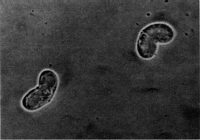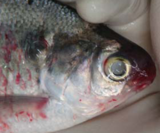- Ceratomyxa shasta
-
Ceratomyxa shasta 
Ceratomyxa shasta spores Scientific classification Kingdom: Animalia Phylum: Myxozoa Class: Myxosporea Order: Bivalvulida Family: Ceratomyxidae Genus: Ceratomyxa Species: C. shasta Binomial name Ceratomyxa shasta
(Noble, 1950)Ceratomyxa shasta is a myxosporean parasite that infects salmonid fish on the Pacific coast of North America. It was first observed at the Crystal Lake Hatchery, Shasta County, California, and has now been reported from Idaho, Oregon, Washington, British Columbia and Alaska (Bartholomew et al. 1989).
Contents
Life history
In addition to the fish host, C. shasta infects a freshwater polychaete worm (Bartholomew et al., 1997). Actinospores are released from the worm, and infect fish, on contact, in the water column. Neither horizontal (fish to fish), nor vertical (fish to egg) transmissions have been documented under laboratory conditions, suggesting that the worm host is necessary for completion of the life cycle.
Spores are released back into freshwater system after its fish host dies, however the complete life cycle, host and vector interaction is not fully understood (especially the ecology of the polychaete host).
Research indicates that the potential for infection is enhanced when water temperatures are high, water flow is low, or numbers of infectious C. shasta are relatively high. Infection rates appear to be higher in or below still water environments than riverine ones.
Pathology of infection
Clinical indications of infection in salmons include lethargy, loss of body mass, darkening of the skin, ascites, exopthalmia and kidney pustules, These symptoms vary from one salmonid species to another, and also depend on life stage of the host.
Internally, infection with C. shasta affects entire digestive tract, liver, gall bladder, spleen, gonads, kidney, heart, gills, and muscle tissues. Infection with C. shasta in adult chinook salmon causes mortality through intestinal perforations and co-occurring bacterial infections.
Cold temperatures and salinity may reduce progress of disease, but do not eliminate infection. Progression of infection and mortality is temperature dependent, with higher temperature increasing disease progression and resulting in quicker mortality.
Disease Resistance
Salmonid stocks exhibit variable resistance to C. shasta (Bartholomew 1998). Resistance is variable and may be compromised by environmental conditions which enhance infectivity. Salmonid stocks which are resistant to C. shasta are not necessarily resistant to other myxosporean infections, such as Myxobolus cerebralis.
References
- Bartholomew, J. L. (1998). Host resistance to infection by the myxosporean parasite Ceratomyxa shasta: a review. Journal of Aquatic Animal Health. 10:112-120.
- Bartholomew, J.L., Rohovec, J.S., & Fryer J.L. (1989). Ceratomyxa shasta, a Myxosporean Parasite of Salmonids. U.S. Fish & Wildlife Service, National Fisheries Research Center
- Bartholomew, J. L., M. J. Whipple, D. G. Stevens and J. L. Fryer. (1997). The life cycle of Ceratomyxa shasta, a myxosporean parasite of salmonids, requires a freshwater polychaete as an alternate host. American Journal of Parasitology. 83:859-868.
- Noble, E. R. (1950). On a myxosporidian (protozoan) parasite of California trout. Journal of Parasitology 36:457-460.
External links
Pathogens - Aeromonas salmonicida
- Columnaris
- Enteric redmouth
- Fin rot
- Fish dropsy
- Flavobacterium
- Hematopoietic necrosis
- Heterosigma akashiwo
- Hole in the head
- Hypodermal and hematopoietic necrosis
- Infectious pancreatic necrosis
- Koi herpes virus
- Novirhabdovirus
- Pfiesteria piscicida
- Photobacterium damselae ssp piscicida
- Salmon anemia
- Streptococcus iniae
- Taura syndrome
- UDN
- VHS
- White spot
- Yellowhead

Parasites - Abergasilus
- Amoebic gill disease
- Carp lice
- Ceratomyxa shasta
- Dactylogyrus vastator
- Diphyllobothrium
- Epizootic ulcerative syndrome
- Flukes
- Glugea
- Gyrodactylus salaris
- Henneguya zschokkei
- Ich (freshwater)
- Ich (marine)
- Kudoa thyrsites
- Lernaeocera branchialis
- Myxobolus cerebralis
- Nanophyetus salmincola
- Salmon lice
- Saprolegnia
- Schistocephalus solidus
- Sea louse
- Sphaerothecum destruens
- Swim bladder disease
- Tetracapsuloides bryosalmonae
- Velvet
Related topics Categories:- Myxozoa
- Fish diseases
- Veterinary parasitology
Wikimedia Foundation. 2010.
